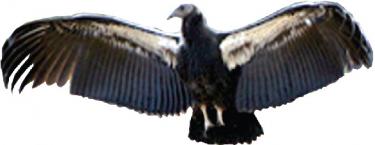The clock is ticking down to April 25, the deadline set by the U.S. Fish and Wildlife Service for comments from the public regarding what should be included in the analysis of Tejon Ranch Company’s request for an "incidental take permit" to kill or harass the California condor and 33 other endangered and threatened species.
By Lynn Stafford
David Clendenen spoke in a dynamic and sobering program this month, telling about his fifteen years with the Condor Recovery Program as a biologist with the U.S. Fish and Wildlife Service
Clendenen is resource specialist at The Wildlands Conservancy’s nearby Wind Wolves Preserve, but he spoke for himself at the event hosted April 5 by the Condor Group of the Sierra Club.
Eloquently and precisely, he discussed the history of the California Condor, its current status and future challenges. His exceptional photographs helped provide an overview exploring the uncertain future for this great but imperiled creature, the largest flying land birds in North America.
Condors are huge scavengers with nine and a half foot wingspans, roaming great distances in search of food. They live long lives, up to 75 years, have traditional ways and complex social structures passed from generation to generation.
They breed slowly, an average of one chick every two years. They are intelligent, curious, able to learn quickly, and are more flexible in behavior than hawks and other raptors. Yet by 1982, there were only twenty-two of these magnificent birds left on earth.
The factors that have brought them to the brink of extinction are all directly related to the activities of people.
First was the development of ranch lands in the West. The large carcass-producing hoofed animals like deer and elk that roamed through California were replaced by domesticated cattle. Predators, such as grizzly bears, coyotes and mountain lions were killed using poisoned bait, which also poisoned condors and other scavengers during the late 1800s and early 1900s. The practice was made illegal in the mid-1900s. But loss of habitat, direct shooting and lead poisoning combined with the condors’ slow reproductive cycle, starting the downward spiral.
During the 1980s lead poisoning from hunters’ bullets was documented as a source of mortality in condors. It had undoubtedly been a serious cause of mortality ever since Europeans arrived with guns and began hunting large animals. Fragments of bullets are ingested as condors feed on the carcass of an animal that has been shot. Lead is a powerful toxin that causes neurological damage and often death. It only takes a piece the size of a fingernail clipping to kill a condor. Less than that can cause neurologic damage that affects the big birds’ ability to navigate in the air.
In the 1980s, the wild population was dwindling dangerously low. Zoos had learned how to raise young at an accelerated rate. So the last few wild birds were captured and brought into zoo programs to build their populations up. Slowly, captive-reared birds began to be reintroduced during the 1990s into Southern California and northwestern Arizona. They are tagged, monitored and partially fed with lead-free carcasses of still-born dairy calves.
At first, the condors’ intelligence and natural curiosity was a problem. They learned to identify with people, and appeared to be attracted to them and their settlements as a potential source of food, as residents of Pine Mountain remember from a few years ago.
Since then, rearing and release techniques have improved. Released birds are acting more like wild animals.
A new problem, dubbed "microtrash," has emerged since the reintroduction of captive- reared condors began in the 1990s.
Condors are curious. They are attracted to small bits of trash such as pop tops, bottle caps and various broken bits of glass and plastic. Historically, parent condors feed small pieces of bone to their chicks. The minerals are useful to the chicks’ growth. It is thought that microtrash is given mistakenly as bone. Scientists have confirmed that this has led to the deaths of several chicks while still in the nest.
The wild population of this ancient creature is now just 155 birds in three different populations in California, Arizona and the northern peninsula of Baja, Mexico. Progress is being made to bring the species back from the edge of extinction. Chicks are being successfully hatched and raised in the wild. The species is not yet fully-independent with self-sustaining populations in the wild, but the threat of extinction is no longer an eminent danger. Great strides have been made to treat this species as a national treasure.
Continuing problems with diminishing habitat, reduced food supplies, the presence of lead, other toxins and microtrash persist. An excellent example of the future uncertainty for the condor is right here in our own region’s Tejon Ranch. Tejon Ranch Company (TRC) is a real estate development and management company that controls 272,000 acres. The land’s developers often identify it as "the largest contiguous holding of private property in California." The area also contains some of the best traditional foraging habitat for the California condor.
It is good news that TRC recently banned lead bullets from its hunting programs. Bravo! However, TRC is currently firming up plans for at least three large-scale housing and commercial developments, including a sprawling upscale ranchette-type community to be called Tejon Mountain Village. This plan will greatly impact the condor, which for thousands of years has used the warm updrafts from the slopes which are part of the proposed development to launch its long glides across the valleys, watching for food.
At the present, a Multi- Species Habitat Conservation Plan for the Tehachapi Uplands is being developed by Tejon Ranch Company. Though the title speaks of conservation, the document is a required preliminary in TRC’s petition for the grant of an Incidental Take permit for the condor. This kind of permit to incidentally kill a condor in the course of TRC’s future developments has never been granted.
Such a permit would be a very dangerous precedent for endangered species in the United States. At least one condor, a matriarch mother dubbed "AC8" by the scientists in the recovery program, has already been shot by a hunter on a Tejon commercial hunt. This bird, about 40 years old, was one of the last of those wild survivors brought into the recovery program during the 1980s.
She hatched several chicks, then was released back into the wild. Her deep knowledge of the roosting and foraging areas of this region was especially important to be transferred to the juvenile condors for their survival in the wild. Her death was a profound loss to the California condor recovery program.
Read more about the call for public comments about what factors should be considered in the study regarding the "take" permit on page 25 in the print issue of The Mountain Enterprise for April 18, 2008. To read the online version, please click here. It may also be viewed at any time in the Community FYI section of our website (left column on any page).
This is part of the April 18, 2008 online edition of The Mountain Enterprise.
Have an opinion on this matter? We'd like to hear from you.



